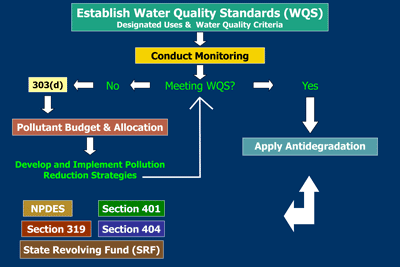Total Maximum Daily Loads (TMDLs)
If monitoring and assessment indicate that a water body or segment fails to meet one or more water quality standard and it is, therefore, placed on the 303(d) list, then the relevant entity (state, territory, or authorized tribe) is required to assess and allocate pollutant loads in a manner that would lead to attainment of WQS. The process of quantifying existing pollutant loads and calculating the load reductions needed to meet WQS is required under section 303 of the CWA, which describes the result as the “Total Maximum Daily Load.”
The CWA requires that Total Maximum Daily Loads (TMDLs) be developed only for waters affected by pollutants where implementation of the technology-based controls imposed upon point sources by the CWA and EPA regulations would not result in achievement of WQC. At this point in the history of the CWA, most point sources have been issued NPDES permits with technology-based discharge limits. In addition, a substantial fraction of point sources also have more stringent water quality-based permit limits. But because nonpoint sources are major contributors of pollutant loads to many water bodies, even these more stringent limits on point sources have not resulted in attaining WQS.
Strategies that help to achieve WQS must consist of a TMDL or another comprehensive effort that includes the functional equivalent of a TMDL implementation plan. Some states have developed watershed management plans that address water bodies that are threatened or affected by pollution. The key point to remember is that TMDLs are “pollutant budgets” for a specific water body or segment that, if not exceeded, would result in attaining WQS.
One somewhat unique program that can address water quality impacts with or without a TMDL is authorized by section 320 of the CWA, the National Estuary Program.
Web Resources
EPA’s National Estuary Program

![[logo] US EPA](https://www.epa.gov/epafiles/images/logo_epaseal.gif)